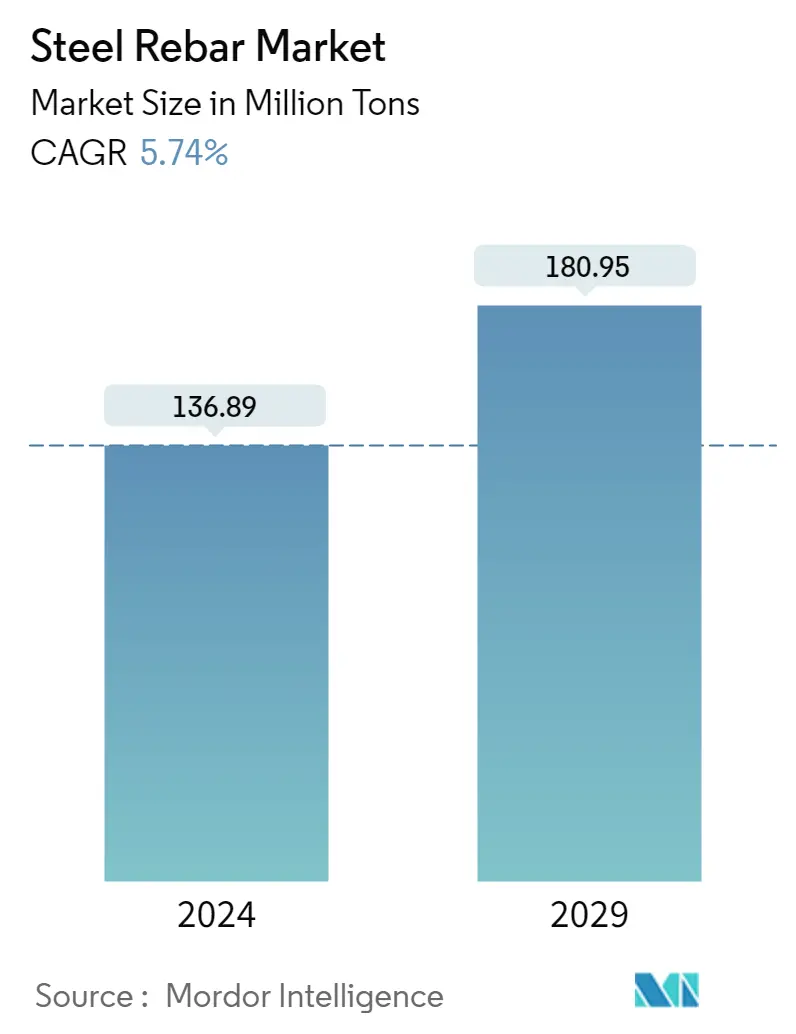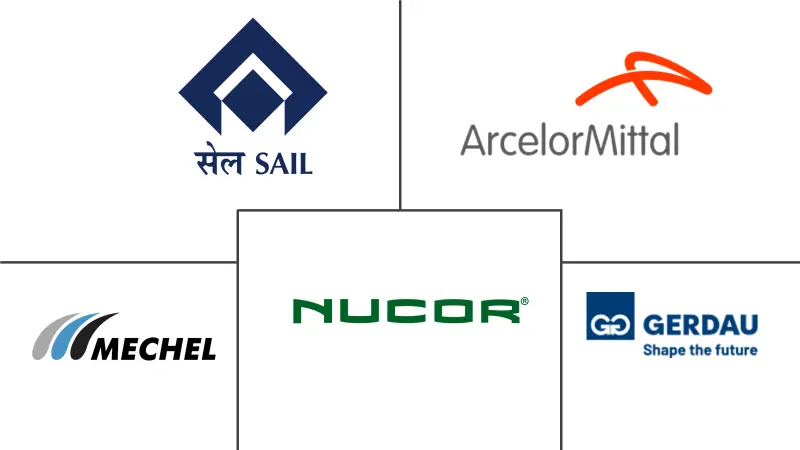Market Size of Steel Rebar Industry

| Study Period | 2019 - 2029 |
| Base Year For Estimation | 2023 |
| CAGR (2024 - 2029) | 5.74 % |
| Fastest Growing Market | Asia Pacific |
| Largest Market | Asia Pacific |
| Market Concentration | Low |
Major Players
*Disclaimer: Major Players sorted in no particular order |
Steel Rebar Market Analysis
The Steel Rebar Market size is estimated at 136.89 Million tons in 2024, and is expected to reach 180.95 Million tons by 2029, growing at a CAGR of 5.74% during the forecast period (2024-2029).
Due to the COVID-19 outbreak, nationwide lockdowns around the globe, disruption in manufacturing activities and supply chains, production halts, and labor unavailability have negatively impacted the steel rebar market. However, the industry witnessed a recovery in 2021, thus rebounding the demand for the market studied.
- Over the short term, rising investments in infrastructure development projects and construction activities are some of the factors driving the growth of the market studied.
- On the flip side, the availability of cheap substitutes for steel rebar is likely to hinder the growth of the market studied.
- However, rising infrastructural activities in developing countries are anticipated to provide numerous opportunities over the forecast period.
- Asia-Pacific region dominated the market, owing to the increasing investments in constructing new projects for infrastructural expansion across various countries in the region.
Steel Rebar Industry Segmentation
A steel rebar is a steel bar or mesh of steel wires used in concrete to provide tensile strength. Because of its physical qualities, steel rebar is utilized in the construction of highways, bridges, dams, and dwellings. It provides a solid foundation for the structure being built or constructed, as well as strengthens and assists the concrete under tension. Concrete has high compressive strength but low tensile strength. The market is segmented based on type, end-user industries, and geography. By type, the market is segmented into deformed and mild. By end-user industry, the market is segmented into residential and non-residential. The report offers market size and forecasts for 15 countries across major regions. For each segment, market sizing and forecasts have been done on the basis of volume (Tons) for all the above segments.
| Type | |
| Deformed | |
| Mild |
| End-user Industry | |||||
| Residential | |||||
|
| Geography | |||||||
| |||||||
| |||||||
| |||||||
| |||||||
|
Steel Rebar Market Size Summary
The steel rebar market is poised for significant growth over the forecast period, driven by increasing investments in infrastructure and construction activities globally. The market experienced a downturn due to the COVID-19 pandemic, which caused disruptions in manufacturing and supply chains. However, a recovery was observed in 2021, leading to a resurgence in demand. The Asia-Pacific region, particularly countries like China and India, is expected to dominate the market due to substantial investments in residential and commercial construction projects. The United States also contributes significantly to the market, with its robust construction sector driving demand for steel rebar, especially in non-residential projects. Despite the presence of cheaper substitutes, the ongoing infrastructural developments in developing countries present numerous opportunities for market expansion.
The market landscape is characterized by a partial fragmentation, with key players such as ArcelorMittal, Gerdau S/A, Nucor Corporation, Mechel, and SAIL playing significant roles. Recent strategic moves, like Nucor Corporation's acquisition of a majority stake in California Steel Industries, highlight the dynamic nature of the market. The increasing urbanization and extensive use of steel rebars in non-residential segments, such as oil and gas, infrastructure, and commercial construction, further bolster market growth. Projects like Saudi Arabia's Neom and India's ambitious infrastructure plans are expected to drive demand, ensuring a positive outlook for the steel rebar market in the coming years.
Steel Rebar Market Size - Table of Contents
-
1. MARKET DYNAMICS
-
1.1 Drivers
-
1.1.1 Rapidly Growing Construction Industry in Asia-Pacific Region
-
1.1.2 Increasing Commercial Construction
-
1.1.3 Other Drivers
-
-
1.2 Restraints
-
1.2.1 Availability of Substitutes for Steel Rebar
-
1.2.2 Other Restraints
-
-
1.3 Industry Value Chain Analysis
-
1.4 Porter's Five Forces Analysis
-
1.4.1 Bargaining Power of Suppliers
-
1.4.2 Bargaining Power of Buyers
-
1.4.3 Threat of New Entrants
-
1.4.4 Threat of Substitute Products and Services
-
1.4.5 Degree of Competition
-
-
-
2. MARKET SEGMENTATION (Market Size in Volume)
-
2.1 Type
-
2.1.1 Deformed
-
2.1.2 Mild
-
-
2.2 End-user Industry
-
2.2.1 Residential
-
2.2.2 Non-Residential
-
2.2.2.1 Commercial
-
2.2.2.2 Infrastructure
-
2.2.2.3 Institutional
-
-
-
2.3 Geography
-
2.3.1 Asia-Pacific
-
2.3.1.1 China
-
2.3.1.2 India
-
2.3.1.3 Japan
-
2.3.1.4 South Korea
-
2.3.1.5 Rest of Asia-Pacific
-
-
2.3.2 North America
-
2.3.2.1 United States
-
2.3.2.2 Canada
-
2.3.2.3 Mexico
-
-
2.3.3 Europe
-
2.3.3.1 Germany
-
2.3.3.2 United Kingdom
-
2.3.3.3 France
-
2.3.3.4 Italy
-
2.3.3.5 Rest of Europe
-
-
2.3.4 South America
-
2.3.4.1 Brazil
-
2.3.4.2 Argentina
-
2.3.4.3 Rest of South America
-
-
2.3.5 Middle-East and Africa
-
2.3.5.1 Saudi Arabia
-
2.3.5.2 South Africa
-
2.3.5.3 Rest of Middle-East and Africa
-
-
-
Steel Rebar Market Size FAQs
How big is the Steel Rebar Market?
The Steel Rebar Market size is expected to reach 136.89 million tons in 2024 and grow at a CAGR of 5.74% to reach 180.95 million tons by 2029.
What is the current Steel Rebar Market size?
In 2024, the Steel Rebar Market size is expected to reach 136.89 million tons.

